
Tumor location
-
Gastrointestinal stromal tumor (GIST) is the most common mesenchymal tumor of the gastrointestinal tract. Stomach is the most affected site. Clinical manifestation is erratic depending on the locations, size, histological type and stage. Confirmed diagnosis of GISTs bases on immunohistochemical study.
 6p
6p  viuchiha
viuchiha
 06-01-2025
06-01-2025
 0
0
 0
0
 Download
Download
-
Gastric cancer (GC) is one of the common types of cancer in Vietnam. Over 50% of GCs are diagnosed at an unresectable stage. Deficiency in mismatch repair proteins (MMR) leading to microsatellite instability (MSI-H) is a crucial prognostic factor currently under investigation in these patients.
 6p
6p  viharuno
viharuno
 03-01-2025
03-01-2025
 4
4
 2
2
 Download
Download
-
Retinoids are potent immune modulators that inhibit Fas ligand (FasL) expression and thereby repress the activationinduced apoptosis of immature thymocytes and T-cell hybridomas. In this study, we demonstrate that all-transretinoic acid (all-trans-RA) directly represses the transcriptional activity of the nuclear factors of activated T-cells (NFAT), which is an important transactivator of the FasL promoter.
 9p
9p  research12
research12
 01-06-2013
01-06-2013
 43
43
 5
5
 Download
Download
-
The eukaryotic glyoxylate cycle has been previously hypothesized to occur in the peroxisomal compartment, which in the yeast Saccharomyces cerevisiae additionally represents the sole site for fatty acid b-oxidation. The subcellular location of the key glyoxylate-cycle enzyme malate synthase 1 (Mls1p), an SKL-terminated protein, was examined in yeast cells grown on dierent carbon sources.
 8p
8p  research12
research12
 01-06-2013
01-06-2013
 45
45
 4
4
 Download
Download
-
The apparent molecular mass of human milk bile salt-stimulated lipase (BSSL) varies between mothers. The molecular basis for this is unknown, but indirect evidence has suggested the dierences to reside in a region of repeats located in the C-terminal part of the protein. We here report that a polymorphism within exon 11 of the BSSLgene is the explanation for the molecular variants of BSSL found in milk.
 9p
9p  research12
research12
 01-06-2013
01-06-2013
 47
47
 4
4
 Download
Download
-
To identify and gain a better understanding of the cadherin-like receptor-binding site onBacillus thuringiensisCry toxins, it is advantageous to use Cry1Aa toxin, because its 3D structure is known. Therefore, Cry1Aa toxin was used to examine the locations of cadherin-like protein-binding sites. Initial experiments examining the binding compatibility for Cry1Aa toxin of partial fragments of recombinant proteins of a 175 kDa cadherin-like protein from Bombyx mori(BtR175) and another putative receptor for Cry1Aa toxin, aminopeptidase N1, fromBo. ...
 14p
14p  research12
research12
 29-04-2013
29-04-2013
 45
45
 3
3
 Download
Download
-
The photosynthetic protein complexes in plants are located in the chloroplast thylakoid membranes. These membranes have an ultrastructure that consists of tightly stackedÔgranaÕ regions interconnectedbyunstackedmembrane regions.The structure of isolated granamembranes has been studiedhere by cryo-electron microscopy. The data reveals an unusual arrangement of the photosynthetic protein complexes, staggered over two tightly stacked planes.
 11p
11p  research12
research12
 29-04-2013
29-04-2013
 43
43
 2
2
 Download
Download
-
We have determined the nucleotide sequence of a zebrafish cDNAclone that codes for a cellular retinol-binding protein type II (CRBPII). Radiation hybrid mapping revealed that the zebrafish and human CRBPII genes are located in syntenic groups.In situhybridization and emulsion autora-diography localized theCRBPIImRNA to the intestine and the liver of adult zebrafish.
 8p
8p  research12
research12
 23-04-2013
23-04-2013
 46
46
 4
4
 Download
Download
-
The amino acid glycine is identified as a component of the inner core oligosaccharide in meningococcal lipopolysac-charide (LPS). Ester-linked glycine residues were consis-tently foundbymass spectrometry experiments tobe located on the distal heptose residue (HepII) in LPS from several strainsofNeisseriameningitidis.Nuclearmagnetic resonance studies confirmedand extended this observation locating the glycine residue at the 7-position of theHepIImolecule inL3 and L4 immunotype strains.
 7p
7p  research12
research12
 23-04-2013
23-04-2013
 43
43
 2
2
 Download
Download
-
During starvation induced encystment, cells of the myxo-myceteDidymiumiridisaccumulate a7.5-kbRNAthat is the result of alternative processing of pre-rRNA. The 5¢ end corresponds to an internal processing site cleaved by the group I-like ribozyme DiGIR1, located within the twin-ribozyme intron Dir.S956-1. The RNAretains the majority ofDir.S956-1 including thehoming endonuclease geneanda small spliceosomal intron, the internal transcribed spacers ITS1 and ITS2, and the large subunit rRNAlacking its two group I introns. ...
 9p
9p  tumor12
tumor12
 22-04-2013
22-04-2013
 30
30
 2
2
 Download
Download
-
NTPDase1 and NTPDase2 are two related plasma mem-brane-located enzymes involved in the extracellular degra-dation of nucleoside 5¢-tri- and -diphosphates. They differ regarding their hydrolysis ratios for ATP and ADP. Both enzymes have a predicted transmembrane domain close to the N- and C-terminus, respectively, connected by an extensive extracellular domain that carries the active site.We expressed the rat-derived enzymes inXenopus laevisoocytes and analyzed their quarternary structure.
 8p
8p  fptmusic
fptmusic
 16-04-2013
16-04-2013
 34
34
 5
5
 Download
Download
-
The complex C1 triggers the activation of the Complement classical pathway through the recognition and binding of antigen–antibody complex by its subunit C1q. The globular region of C1q is responsible for C1 binding to the immune complex. C1q can also bind nonimmune molecules such as DNAand sulfated polysaccharides, leading either to the activation or inhibition of Complement. The binding site of these nonimmune ligands is debated in the literature, and it has beenproposed to be located either in the globular region or in the collagen-like regionof C1q, or inboth....
 7p
7p  fptmusic
fptmusic
 12-04-2013
12-04-2013
 41
41
 2
2
 Download
Download
-
Plectin, a large and widely expressed cytolinker protein, is composed of several subdomains that harbor binding sites for a variety of different interaction partners. A canonical actin-binding domain (ABD) comprising two calponin homology domains (CH1 and CH2) is located in proximity to its amino terminus. However, the ABD of plectin is unique among actin-binding proteins as it is expressed in the form of distinct, plectin isoform-specific versions.
 12p
12p  dell39
dell39
 03-04-2013
03-04-2013
 38
38
 3
3
 Download
Download
-
The interaction of the adenylate cyclase catalytic domain (AC) of the Bordetella pertussismajor exotoxin with its activator calmodulin (CaM) was studied by time-resolved fluorescence spectroscopy using three fluorescent groups located indifferent regions ofAC: tryptophan residues (W69 and W242), a nucleotide analogue (3¢-anthraniloyl-2¢-deoxyadenosine 5¢-triphosphate, Ant-dATP) and a cysteine-specific probe (acrylodan).
 13p
13p  dell39
dell39
 03-04-2013
03-04-2013
 24
24
 4
4
 Download
Download
-
Integrase of the human immunodeficiency virus type-1 (HIV-1) recognizes specific sequences located in the U3 and U5 regions at the ends of viral DNA. We synthesizedDNA duplexes mimicking the U5 region and containing either 2¢-aminonucleosides or non-nucleoside 1,3-propanediol insertions at the third and terminal positions and studied their interactions with HIV-1 integrase. Both modifications introduced a local structural distortion in the DNA double helix.
 7p
7p  dell39
dell39
 03-04-2013
03-04-2013
 32
32
 3
3
 Download
Download
-
The superfamily of proteins containing C-type lectin-like domains (CTLDs) is a large group of extracellular Metazoan proteins with diverse functions. The CTLD structure has a characteristic double-loop (‘loop-in-a-loop’) stabilized by two highly conserved disulfide bridges located at the bases of the loops, as well as a set of conserved hydrophobic and polar interactions.
 39p
39p  dell39
dell39
 27-03-2013
27-03-2013
 39
39
 5
5
 Download
Download
-
Plasminogen activator inhibitor type 1 (PAI-1) is induced by many proin-flammatory and pro-oxidant factors. Among them, tumor necrosis factora (TNFa), a pivotal early mediator that regulates and amplifies the develop-ment of inflammation, is one of the strongest PAI-1 synthesis activators. Location of the TNFa response element in the PAI-1 promoter is still ambiguous.
 11p
11p  dell39
dell39
 27-03-2013
27-03-2013
 46
46
 4
4
 Download
Download
-
HIC1(hypermethylated in cancer) is a tumour suppressor gene located in 17p13.3, a region frequently hypermethylated or deleted in many types of prevalent human tumour.HIC1is also a candidate for a contiguous-gene syndrome, the Miller–Dieker syndrome, a severe form of lissencephaly accompanied by developmental anomalies.
 12p
12p  inspiron33
inspiron33
 25-03-2013
25-03-2013
 36
36
 3
3
 Download
Download
-
Carbamoylphosphate synthetase-I is the flux-determining enzyme of the ornithine cycle, and neutralizes toxic ammonia by converting it to urea. An 80 bp glucocorticoid response unit located 6.3 kb upstream of the trans-cription start site mediates hormone responsiveness and liver-specific expression of carbamoylphosphate synthetase-I.
 9p
9p  inspiron33
inspiron33
 23-03-2013
23-03-2013
 40
40
 3
3
 Download
Download
-
In vascular smooth muscle cells and several other cell types, inhibition of Na + ⁄K + -ATPase leads to the expression of early response genes, including c-Fos. We designed this study to examine whether or not a putative Na + i ⁄K + i-sensitive element is located within the c-Fos5¢-UTR from )650 to +103 containing all known response elements activated by ‘classic’ stimuli, such as growth factors and Ca 2+ i-raising compounds.
 11p
11p  galaxyss3
galaxyss3
 19-03-2013
19-03-2013
 38
38
 3
3
 Download
Download
CHỦ ĐỀ BẠN MUỐN TÌM








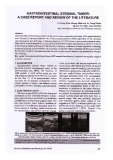
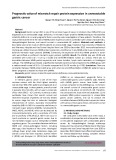
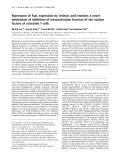
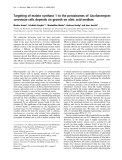
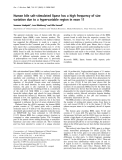
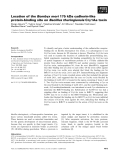
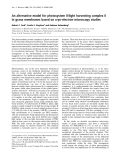
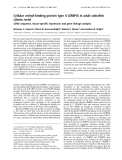
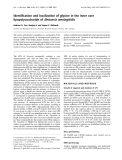
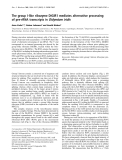
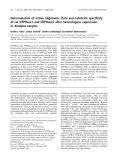
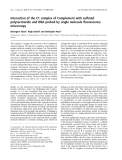
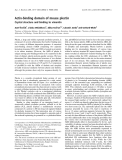
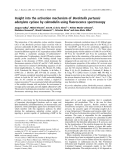
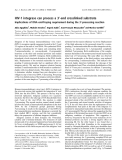
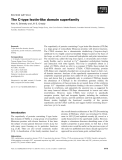
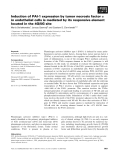
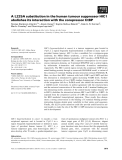
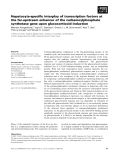
![Báo cáo khoa học: [Na+]i-induced c-Fos expression is not mediated by activation of the 5¢-promoter containing known transcriptional elements Báo cáo khoa học: [Na+]i-induced c-Fos expression is not mediated by activation of the 5¢-promoter containing known transcriptional elements](https://tailieu.vn/image/document/thumbnail/2013/20130319/galaxyss3/135x160/8161363693709.jpg)




